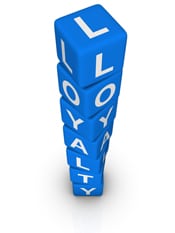How to Build Loyalty with “Next Best” Customers
By Rodney Mason
Today’s most important strategy in the incentives space is a shift to loyalty programs. Just offering rewards is no longer enough to change consumer behavior. Brand “stickiness” is more and more essential. Now, incentive-based loyalty programs are being driven by competitors who have loyalty programs, a desire for the best customers to remain loyal and a needed boost in overall sales
 There is often a preconceived notion that a loyalty program—using points, catalogs, exclusive access and other incentives—keep best customers happy so they remain loyal and spend more with their favorite brands.
There is often a preconceived notion that a loyalty program—using points, catalogs, exclusive access and other incentives—keep best customers happy so they remain loyal and spend more with their favorite brands.
The truth is that best customers are important. They must be carefully monitored and managed. But they are already dedicated brand fans and offer minimal incremental volume increases. Most often, the greatest opportunity lies in next best customers.
Typically, there are significantly more next best customers than best customers. The next bests are heavy category consumers; they just aren’t particularly loyal to your brand. To convert these people to become your best customers, it is essential to identify their key loyalty drivers—meaning the incentives they value most.
Start by identifying customer macro segments based on buying habits and preference commonalities. Be sure to measure how much or often they consume your product. These segments can be drilled down further to identify the specific incentives that will motivate them to purchase more frequently or in greater quantities.
Several rounds of research (or in-market testing) can identify the most powerful incentives. Then, appropriate strategies can be developed to change behaviors to your benefit. Core loyalty drivers often include:
• Acknowledgement “Thank You” communications and exclusive incentives—such as rewards, values, and access to special events—are designed to make your best customers feel special and appreciated. As a result, they stay loyal and happy.
• Time Compression Incentives can increase the number of average purchases during a calendar period. For example, a loyal customer should earn a special reward when buying twice during a month (as opposed to currently purchasing once per month).
• Increase Average Purchase Loyalty incentives can also reward shoppers for spending more per transaction. For example, give consumers rewards when they buy greater quantities or more products at one time. If an average purchase is $20, incent and reward to make it $30.
• Status Perks Offer exclusive rewards for being a higher-status customer. These incentives often involve a special form of currency (such as points) associated with redemption.
• Product in Kind Often co-mingled with other tactics, “free” products can be powerful incentives for customers. Plus, these rewards typically cost you less than any other reward, thanks to a customer’s perception of your product’s value.
We conducted a national study this year that found 55% of consumers shop where they find value from loyalty and rewards programs. The same study found consumers are much more sensitive to price, due in large part to significant decreases in their spending power.
In fact, in every income level under $200,000, price is rated as significantly more important than brand. These trends identify a seismic shift in consumers’ path-to-purchase behaviors: They want to receive greater value for being recognized as loyal customers.
Identifying the segments that hold the most promise for growth can also reveal the most powerful incentives to change consumer behavior in your favor. Initially, you can provide rewards based on insights, using various proven, effective marketing innovations.
For example, one marketing innovation is an action-triggered prepaid card; these cards are delivered directly to consumers with a zero- or small-value load. Additional cash value is automatically loaded when consumers complete specific behaviors. Another tactic is to offer exclusive rebates for fulfilling time and quantity requirements. And online redemption stores loaded with appropriate rewards can also drive behavioral changes.
Understanding customer segments, the incentives that drive their loyalty, and the opportunities to change their behaviors can grow your baseline. Even if you don’t plan to launch a traditional “loyalty program,” the right reward strategies can still be a key, leading differentiator in a market sector.
Sure, competitors will take note of these incentive-to-loyalty initiatives. But unless they invest in the research to truly understand their own customer segments, they will never fully understand the impact that a data-driven, sticky program makes on the market.
Rodney Mason is chief marketing officer of Parago.































